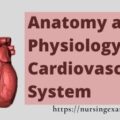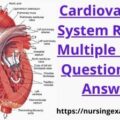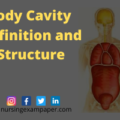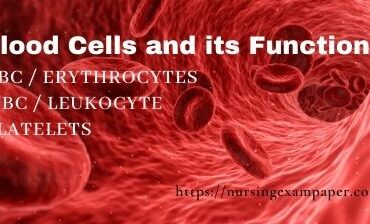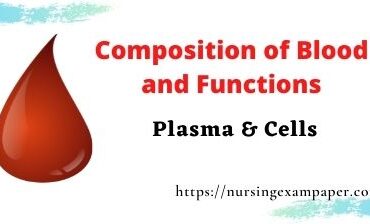The heart is a muscular organ located in the thoracic cavity in between the lungs. Its main function is to pump blood to all parts of your body. The size can vary depending on the size, age, and condition of the heart. But, the heart is normally a little larger than the size of our fist. There are some diseases that can cause it to become larger such as thyroid disorder and high blood pressure or hypertension. The heart has four chambers and valves.
The heart has four chambers. The Right and Left atria, and the Right and Left ventricle. Arteries and veins are the main blood vessels that are directly connected to the cardiovascular system. The right ventricle pumps blood from your heart to your lungs to get fresh or oxygenated blood, then the left atrium receives fresh blood from your lungs. The left ventricle sends fresh blood through the aorta to the rest of the body.
The Right and Left side of the Heart and its Blood flow
The superior and inferior vena cava are the largest veins which are located on the right side of the heart. Superior vena cava carries used blood or deoxygenated blood from the upper part of the body while inferior vena cava carries used blood from the lower parts of the body. The used blood from both vena cava flows into the right atrium and then to the right ventricle.
From the right ventricle, the used blood is pump to the lungs via pulmonary arteries to get another fresh or oxygenated blood. From the lungs, fresh blood passes through the pulmonary veins back to the heart. In the left of the heart, fresh blood enters the left atrium and is pumped into the left ventricle and pumped to the rest of the body through the aorta. The heart is being supplied with oxygen-rich blood through the coronary arteries which are connected to the left ventricle. Their main function is to supply blood to the wall of the heart.
Heart Chambers
The heart consists of four chambers that are connected by valves. Chambers participates in the pumping cycle of the blood. These include the two atria and two ventricles. Atria is located in the upper portion of the heart and separated by a septum into the left and right atrium. Ventricles are located in the lower portion of the heart, a part where blood stays before pumping out to the heart. Compared to atria, a ventricle has performed more effort because blood volume distribution depends on its function.
Four chambers of the heart
The atria of the heart receive used or deoxygenated blood from all areas of the body. It primarily acts as a reservoir, where blood return from veins collets before it enters the ventricles. As it contracts blood forces into the ventricles and ventricular filling occur. The right and left atrium are separated from each other by the interatrial septum – a partition consisting of a cardiac muscle.
Functions of Right and Left Atrium
Right Atrium – It has two major openings, the superior and inferior vena cava. The superior vena cava carries deoxygenated blood from the upper part of the body such as head and neck. While the inferior vena cava returns deoxygenated blood from the lower body part like abdomen, pelvis and lower extremities. Blood that used by the heart also enters the right atrium via a coronary sinus.
Left Atrium – It has four openings that receive blood from the lungs via four pulmonary veins. The pulmonary veins extend from the left atrium to the lungs and bring fresh or oxygenated blood.
Functions of Right and Left Ventricles
Ventricles are major pumping chambers and thicker than the atria because it produced more effort in pumping blood to all body parts. Ventricle primarily ejects blood into the arteries and forces it to flow through the circulatory system. With each single contraction blood with pressure is distributed to all connected organs. The thickening of the ventricles is called ventricular hypertrophy. Both ventricles are separated from each other by the interventricular septum.
Right Ventricles – It receives used blood from the right atrium and pumps it to the lungs through the pulmonary artery to get fresh blood. If there is too much volume in the lungs or know as pulmonary congestion contraction activity effort of the right ventricles is affected.
Left ventricle – Its wall is thicker than the wall of the right ventricle because it produces more pressure. 120 mm Hg is an approximate pressure produced by the left ventricle. The left ventricle receives fresh blood from the left atrium and pumps it to the aorta. Aorta is the largest artery which carries and distributes oxygenated blood to the upper and lower part of the body.
Heart valves are flap-like structures located within the heart chambers. Valves allow the proper flow of blood through the heart in one direction. It controls the blood flow by opening and closing during heart contraction. Valves’ movements are controlled by blood pressure and some muscle contraction.
If the valve doesn’t close properly and there is blood leaking backward it is called Mitral Valve prolapse. Mitral valve prolapse is a common heart valve disease-causing irregular heartbeat or arrhythmia.
Heart Valves
There are two kinds of valves, the Atrioventricular Valves, and Semilunar Valves.
Two Atrioventricular Valves:
Atrioventricular Valves or also known as Cuspid valves are located between the atria and ventricles. They primarily prevent blood back-flow from the ventricles (lower portion of the heart) and atrium (upper portion of the heart). Atrioventricular Valves are connected to the ventricles by cone-shaped muscular pillars called papillary muscles. Papillary muscles are attached by chordae tendineae – a strong thin and strong connective tissue strings. These strings prevent the valve from invertion.
Tricuspid valve – The valve is located between the right atrium and right ventricle. It is three-flapped valves that prevent or stop the back-flow of blood between the two chambers. It has three cusps.
Mitral Valve or Bicuspid Valve – Is located on the left side of the heart specifically in the left atrium and left ventricle. It has two cups.
Semilunar Valves:
Semilunar Valves are smaller types of valves that are shaped like a moon. They are located between the left ventricle and aorta and the pulmonary artery and right ventricle. It permits the flow of blood to be forced into the valves and as well as prevents blood back-flow from the arteries into the ventricles.
Aortic Valve – Its located between the aorta and the left ventricle. It has three cusps. It primarily prevents the backflow of blood as it is pumped from the left ventricle to the aorta. As the left ventricular increases its pressure due to cardiac contraction the aortic valve opens, allowing the flow of blood into the aorta. When the pressure from the left ventricle decreases, the aortic pressure forces the aortic valve to close.
Pulmonary Valve – Is sometimes referred to as the pulmonic valve. It is located between the right ventricle and pulmonary artery and has three cusps. It prevents the backing flow of blood from the right ventricle to the pulmonary artery. The opening and closing of the pulmonary semilunar valves are controlled by pressure produced by the right ventricle and pulmonary artery.
Cardiac Diagnostic Tests and Procedures To Diagnose Heart Disease
Cardiovescular System Related Multiple Choice Questions and Answers

